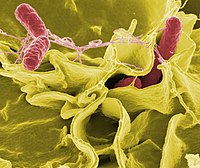
Photo from wikipedia
The objective of the present study was to characterize Salmonella enterica serovar Infantis isolated from chicken meat determining their clonal relationships with S. Infantis isolated from children with diarrhea. Fifteen… Click to show full abstract
The objective of the present study was to characterize Salmonella enterica serovar Infantis isolated from chicken meat determining their clonal relationships with S. Infantis isolated from children with diarrhea. Fifteen meat-recovered S. Infantis were analyzed. Susceptibility levels to 14 antibacterial agents, the presence of ESBL and that of inducible plasmid-mediated AmpC (i-pAmpC) were determined by phenotypical methods. The presence of ESBL and pAmpC was confirmed by PCR, and detected ESBL-encoding genes were sequenced and their transferability tested by conjugation. The presence of gyrA mutations as well as Class 1 integrons was determined by PCR. Clonal relationships were established by REP-PCR and RAPD. In addition, 25 clinical isolates of S. Infantis were included in clonality studies. All meat-recovered S. Infantis were MDR, showing resistance to ampicillin, nitrofurans and quinolones, while none was resistant to azithromycin, ceftazidime or imipenem. ESBL (blaCTX-M-65) and i-pAmpC (blaDHA) were detected in 2 and 5 isolates respectively (in one case concomitantly), with blaCTX-M-65 being transferable through conjugation. In addition, 1 isolate presented a blaSHV gene. All isolates presented D87Y at GyrA, nalidixic acid active efflux pump and a Class 1 integron of ~1000 bp (aadA1). Clonal analysis showed that all isolates were related. Further they were identical to MDR blaCTX-M-65-producing S. Infantis isolates causing children diarrhea in Lima. The dissemination of MDR blaCTX-M-65-producing S. Infantis between marketed meat and children highlights a public health problem which needs be controlled at livestock level.
Journal Title: International journal of food microbiology
Year Published: 2021
Link to full text (if available)
Share on Social Media: Sign Up to like & get
recommendations!